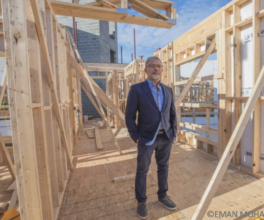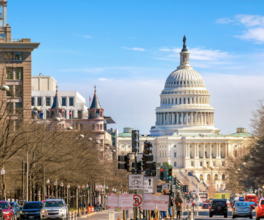For those who have seen the evolution of Georgia Avenue in the District, there were the days of outdoor heroin markets, dangerous go-go clubs and residents afraid to go to their favorite barbershop.
Those days, for the most part, have been relegated to the not-so-distant past. But more change is on the way for the strip of liquor stores, neighborhood restaurants and long-held businesses that serve as the facade for a community of adjoining, brilliantly colored rowhouses.
Residents say they have seen the effects of gentrification and displacement — in the District and across the country — as development has flourished and trends redefined realities for neighborhoods. They hear that development and neighborhood change are shaped by the invisible hands of the economy and behind the mysterious cloak of political deal-making.
They think that there’s a better way and that they have the opportunity — before projects are approved and businesses are ready to move in — to influence the forces of progress. Looking to take on the challenge is a group of residents who call themselves the Georgia Avenue Community Development Task Force. They have a large enough presence to apply pressure on city leaders and do their own deal-making to ensure that the Northwest D.C. neighborhood becomes what residents want.
Residents say they don’t trust timelines that have been repeatedly lengthened or forgotten.
“It’s about empowering ourselves to do something, rather than twiddling our thumbs and five or 10 years goes by and nothing happens,” said Sylvia Robinson, who runs the Emergence Community Arts Collective. As a leader of the task force, some consider her the neighborhood’s “unofficial mayor.”
The group takes on projects big and small. Abandoned storefronts are a problem in the neighborhood, and the group hopes to showcase artists’ work there as part of a “window walk,” creating a sense of community and cleaning up eyesores.
The first such project was installed Saturday by artist John Grunwell as the group helped kick off the Georgia Avenue/Pleasant Plains Heritage Trail, another goal of the task force. The idea behind Grunwell’s self-described “psychedelic” work has its roots in other District mural projects, which create a sense of pride and are a way to clean up blight, task force members said.
The group’s efforts circle back to residents who don’t want to be overtaken by outsiders.
“We do want new people on Georgia Avenue,” said Darren Jones, a task force leader. “But we want to make sure that the people who want to stay can stay and shape Georgia Avenue in the way we want.”
‘We need more foot traffic’
Georgia Avenue poses development challenges that differ from those in other areas of the city.
The parcels and buildings are aging and small, making renovation difficult. Big projects elsewhere — the Target in Columbia Heights or Whole Foods Market near Logan Circle, for example — were possible because there were large or adjoining parcels for the taking. Such projects would be difficult on Georgia Avenue, developers say.
Adrian Washington, who heads Neighborhood Development Co., said he can look at history to see that major change is coming. He said there were plans for Dupont Circle in the 1970s, Logan Circle in the ’80s and Columbia Heights in the ’90s.
“If you start from downtown and the areas near downtown that were already developed .?.?. you can almost draw an arrow and see it moving east,” said Washington, whose company has developed several properties in and around the Georgia Avenue corridor and has more in the pipeline.
“Georgia Avenue is the next place,” he said.
Romeo Morgan, owner of Morgan’s Seafoods, which has been on Georgia Avenue for more than 80 years, has his own plan for a small development around his store.
One of Morgan’s main goals for the project — which would include new stores and apartments, among other amenities — is to bring more people and the money they would spend to the area.
“Look, it’s 5 p.m.,” Morgan said on a recent day, gesturing outside. “We’re talking about three people up here! The biggest issue is we need more foot traffic on Georgia Avenue.”
Redefining the corridor
D.C. Council member Jim Graham (D-Ward 1) apologizes for being “unabashed,” but there has been a lot of progress on Georgia Avenue, he said. A new police substation has provided stability for what came after it, including the Park Place Apartments above the Georgia Avenue-Petworth Metro station, the CVS pharmacy across the street, and the small apartment buildings and lofts that dot the street, Graham said.
There’s also E.L. Haynes Public Charter School and a new senior center.
“Things have come to life on Georgia Avenue,” Graham said. “The revitalization of lower Georgia Avenue is a certainty now, and just a short time ago it wasn’t so certain.”
The historic Howard Theatre is being refurbished near the Shaw-Howard University Metro station, and, across the street, construction has begun on the mixed-use Progression Place, which will include apartments and the future home of the United Negro College Fund.
One of the biggest developments on its way is called Howard Town Center, on the drawing board since 2002. The site is to bring a grocery and other retailers to Georgia Avenue and V Street. The development would encompass several city blocks on lower Georgia Avenue, and residents and Howard students have long wanted to see it finished.
“We continue to work with the District to ensure the successful development of the project as speedily as possible,” Kerry-Ann Hamilton, a Howard University spokeswoman, said in an e-mail.
But lower Georgia Avenue is still a mixed bag. There are pesky liquor stores and vacant storefronts, but also nonprofit organizations and artists’ studios, the kind of neighborhood-friendly businesses many neighbors want to see.
Shirikiana Gerima, co-owner of Sankofa Video Books & Cafe, which sells African heritage books and items, worries about what gentrification could mean for her business.
“We’re like a black church,” Gerima said. “We depend on a black clientele. Without a black clientele, there’s no store. I would like to see businesses that are here be supported. A lot of the businesses up and down Georgia Avenue have been there for decades. You don’t always have to bring in Whole Foods.”
Graham said residents moving to the area, anchored by new housing, will drive the demand for new businesses and services.
No one knows how quickly development might speed up — the economy and other forces play a role beyond what residents can control. But there are things resident can do, they say, and they aren’t going to wait for the city to make good on past promises.
“They do the plans and there’s a lot of hype, and nothing happens,” said Robinson, of the task force. Now, she said, “we’re large enough, and we make a lot of noise.”
Residents put pressure on city leaders to restore more than $1 million in Great Streets streetscape funding to the area and worked with a property owner to bring in a theater and jazz club instead of a liquor store.
“We didn’t like the model of ‘let’s bring people in and then develop the community,’ ” Robinson said. “The change that was coming needed more people at the table .?.?. namely, the community.”



